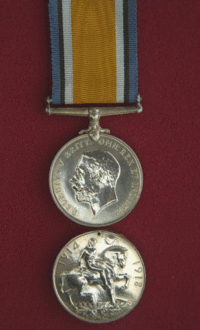British War Medal
The requirements for Royal Air Force (RAF) personnel were the same as for the Army. Naval personnel were required to have 28 days of mobilized service or to have lost their lives before this period of service was complete. Seamen of the Canadian Merchant Marine who served at sea not less than six months, and crews of Dominion Government Ships and the Canadian Mercantile Marine were also eligible.
It was possible to receive this medal alone but all gallantry medals would receive the British War Medal (BWM) and the Victory Medal (VM) as well.
Description
A circular, silver medal, 1.42 inches in diameter. The medal awarded to Chinese, Maltese and Native Labour Corps was bronze.
Obverse
The obverse shows the King George V, bareheaded coinage effigy, facing left, with the legend: GEORGIVS V BRITT : OMN : REX ET IND : IMP :
Reverse
On the reverse, there is a horseman, St. George, armed with a short sword (an allegory of the physical and mental strength which achieves victory over Prussianism). The horse tramples on the Prussian shield and the skull and cross-bones. Off-centre, near the right upper rim, is the sun of Victory. The dates 1914 and 1918 appear in the left and right fields respectively.
Ribbon
The watered ribbon is 1.25 inches wide, and consists of seven stripes: blue, black, white, orange centre, white, black, and blue.
Mounting
For mounting, there is a plain, straight, non-swiveling suspender with a single-toe claw.
Dates
The British War Medal was authorized on 26 July 1919.
Naming
The recipient's name, number and rank are engraved on the rim for the first issue.
Issued
There were 427,993 issued to Canadians in the Canadian Expeditionary Force (CEF) and 6,500,000 in total.
